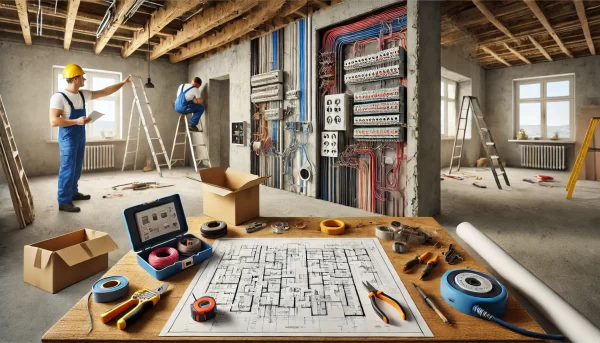
Electrical planning is one of the most critical components of any new build or extension project. A well-designed electrical system not only ensures safety and compliance with building codes but also provides functionality and efficiency for years to come. Whether you’re designing a modern home, expanding your living space, or creating a commercial property, careful consideration of your electrical needs is essential.
This article explores five key tips to help you plan your electrical system effectively for new builds and extensions.
1. Assess Current and Future Needs
When planning your electrical system, think beyond your current requirements. Consider the appliances, devices, and technologies you’ll use now and in the future. This foresight ensures your system can handle evolving energy demands, saving you from costly upgrades later.
For example, if you’re building a home office, plan for sufficient outlets to power computers, printers, and other equipment. Similarly, in living spaces, plan for entertainment systems, smart home devices, and additional lighting. Extensions often serve as multipurpose spaces, so include flexibility in your design to accommodate future changes in usage.
Proper planning ensures your system is adaptable and efficient. Consulting experts in electrical upgrades and renovations can provide insights into scalable solutions tailored to your project.
2. Plan Outlet Placement Strategically
Outlets are one of the most frequently used components of any electrical system, and their placement can significantly impact functionality and convenience. Strategic planning ensures outlets are readily accessible without cluttering your space with extension cords or power strips.
Key Tips for Outlet Placement:
- Living Areas: Place outlets near furniture arrangements for easy access to lamps, chargers, and entertainment devices.
- Kitchen: Ensure outlets are installed above countertops for small appliances and near cooking areas for convenience.
- Bedrooms: Install outlets near bedsides and desks to support nightstand lamps and electronics.
- Outdoor Areas: Include weatherproof outlets for garden tools, lighting, and holiday decorations.
Extensions, such as sunrooms or additional bedrooms, benefit from carefully considered outlet placement to maximize usability without compromising aesthetics.
3. Incorporate Energy Efficiency
Energy efficiency is a key consideration in modern electrical planning. Incorporating energy-saving technologies reduces utility costs and contributes to sustainability. Choose energy-efficient lighting, such as LED bulbs, and appliances with high energy star ratings to optimize performance while minimizing energy use.
Ideas for Energy Efficiency:
- Install programmable thermostats to control heating and cooling.
- Use smart lighting systems that automatically adjust brightness or turn off when not in use.
- Opt for energy-efficient kitchen and laundry appliances that consume less electricity and water.
Integrating these features into your electrical design improves efficiency and adds value to your property.
4. Future-Proof Your Electrical System
Technology evolves rapidly, and future-proofing your electrical system ensures your new build or extension remains functional and relevant for years to come. Pre-installing wiring for smart home systems, electric vehicle chargers, and renewable energy sources like solar panels can save time and money down the line.
Steps to Future-Proof Your System:
- Install additional circuits to accommodate future appliances or devices.
- Leave room in the electrical panel for expansions.
- Include conduit pathways for running extra cables if needed later.
- Plan for smart home automation systems to control lighting, security, and climate.
By preparing for technological advancements, you create a home that adapts seamlessly to changing needs.
5. Hire a Professional Electrician
The most important step in electrical planning for new builds and extensions is hiring a licensed electrician. Professional electricians ensure your system complies with local building codes, is safe to use, and meets your specific requirements. They also provide valuable advice on optimizing your system for efficiency, aesthetics, and functionality.
Working with experienced professionals during the design and installation phase ensures that your project runs smoothly and avoids costly mistakes. Additionally, an electrician can help you navigate permits and inspections, ensuring your electrical work is up to standard.
Conclusion
Effective electrical planning is a cornerstone of any successful new build or extension project. By assessing current and future needs, strategically placing outlets, incorporating energy-efficient technologies, future-proofing your system, and working with licensed professionals, you can create a safe and functional electrical setup tailored to your lifestyle.
Whether you’re building a modern home or expanding an existing property, thoughtful planning and expert guidance will ensure your electrical system enhances comfort, efficiency, and value. To explore customized solutions and expert advice, consult resources on electrical upgrades and renovations. Start planning today to power your new space effectively for years to come.
